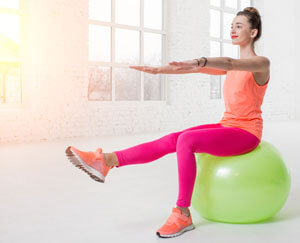Better balance
Falls are the second leading cause of accidental or unintentional injury deaths worldwide according to World Health Organization. To help you prevent falls and improve balance, we’ve compiled a targeted list of exercises. Do them two to three times per week or do a few every day.
Challenging your balance may be as simple as standing on one leg or closing your eyes. But for added challenge and fun, include balance boards, balance cushions or sturdy foam rollers.
Keep safety in mind at all times. Remove objects around you and stand near a wall or stable surface in case you lose your balance. If any move feels wrong or unsafe to you, stop and check with your health care provider. Depending on your health and physical condition, some exercises may not be recommended.
Beginner
Start with these exercises and work your way up to the advanced exercises.
- Calf raise: Find an elevated surface like a stair or a short and sturdy step stool. Stand on the stair so that your heels are hanging off. Rise onto the balls of your feet, lifting your heels as high as possible. Hold at the top for two seconds, then slowly lower down until your feet are parallel with the floor. That's one rep; do 15. For added difficulty and a stretch, lower until your heels are slightly below parallel. You will want to hang on to something when doing this version.
- Superman: Start on your hands and knees, back flat like a table and core tight. Extend your right leg back behind you as you reach your left arm forward. Hold for two seconds, then return to start. Repeat with the left leg and right arm. That's one rep; do 10. If this is too difficult, start just by raising your arm and leg separately. Work your way up to both arm and leg at the same time as described above.
- One-legged balance: With feet together; lift one foot bending at the knee — knee facing forward. Hold the position for five seconds with eyes open, then closed. Switch feet and repeat for four reps on each foot. To ensure safety, stand near a stable chair or a wall just in case you get off balance.
- Leg swings: Stand on your right leg and raise the left leg three to six inches off the floor. With arms at your sides, swing your left leg forward and backward, taping your toe on the floor to help keep balance between front and back motions. Now, repeat the moves, but don't allow your foot to touch the ground.
- One-legged clock with arms: Balance on one leg, torso straight, head up and hands on the hips. Visualize a clock and point your arm straight overhead to 12, then to the side (three) and then circle low and around to nine without losing your balance.
Advanced
Once you master the beginner balance moves on solid ground, try them on an unstable surface such as a BOSU platform or balance board. Keep reading for a few additional advanced balance moves.
- One-legged squat: Stand with your feet hip-width apart. Point your left foot out front, just barely touching the floor, for balance and push your hips back and down into a one-legged squat position. Your right knee is bent, chest upright, eyes forward and your arms out front. Make sure to keep your knee behind your toes. Slowly push up to return to starting position. Switch feet.
- Single-leg dead lift: Balance on your left foot, engage the abs and bend forward at the hips while reaching toward the ground with your right hand and raise your right leg behind you for counterbalance. Tighten the buttocks as you return to the starting position. Keep your knee relaxed and back flat throughout the movement. Switch legs. For added challenge you can hold a five- to 10-pound weight in your hand as you lower.
Exercise with equipment
These exercises may be OK for beginner or advanced balancers, but they require additional equipment.
- Stability ball sits: Sit on top of a stability ball with your feet on the ground and engage your arms and core. Take a deep breath in, then lift your feet off the floor as you exhale and try to stay balanced on the ball. Take your time and practice lifting and lowering your feet until you can hold your balance for 10 seconds. To make it easier, lift only one leg at a time (switch back and forth between left and right legs).
- Elevated plank: Place forearms on a stability ball — with elbow bent and fingers interlaced — and extend legs straight behind, supported on toes. Exhale, pulling belly button toward spine, then hold for 30-60 seconds, back flat and body in a straight line. Rest by placing knees back on the floor for 30 seconds and repeat. Do three times.
- Ball balance: Lie on stability ball on stomach, hands and toes on floor. Exhale and pull abs in to stabilize, then raise right arm forward and left leg back. Breathe and hold for 10 seconds, using ab and back muscles to keep ball steady and body in a straight line, then lower. Repeat with opposite arm and leg. Do five times on each side. To make it easier, lift arm only for five reps, then repeat with opposite leg; switch sides and repeat. To make it harder, hold raised position as you write the alphabet in the air with extended arm; switch sides and repeat.
